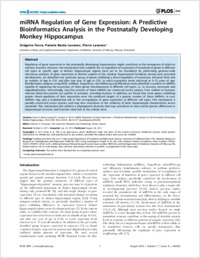miRNA regulation of gene expression: a predictive bioinformatics analysis in the postnatally developing monkey hippocampus
- Favre, Grégoire Laboratory of Brain and Cognitive Development, Department of Medicine, University of Fribourg, Switzerland
- Banta Lavenex, Pamela A. Laboratory of Brain and Cognitive Development, Department of Medicine, University of Fribourg, Switzerland
- Lavenex, Pierre Laboratory of Brain and Cognitive Development, Department of Medicine, University of Fribourg, Switzerland
-
28.08.2012
Published in:
- PLoS ONE. - 2012, vol. 7, no. 8, p. e43435
English
Regulation of gene expression in the postnatally developing hippocampus might contribute to the emergence of selective memory function. However, the mechanisms that underlie the co-regulation of expression of hundreds of genes in different cell types at specific ages in distinct hippocampal regions have yet to be elucidated. By performing genome-wide microarray analyses of gene expression in distinct regions of the monkey hippocampal formation during early postnatal development, we identified one particular group of genes exhibiting a down-regulation of expression, between birth and six months of age in CA1 and after one year of age in CA3, to reach expression levels observed at 6–12 years of age. Bioinformatics analyses using NCBI, miRBase, TargetScan, microRNA.org and Affymetrix tools identified a number of miRNAs capable of regulating the expression of these genes simultaneously in different cell types, i.e., in neurons, astrocytes and oligodendrocytes. Interestingly, sixty-five percent of these miRNAs are conserved across species, from rodents to humans; whereas thirty-five percent are specific to primates, including humans. In addition, we found that some genes exhibiting greater down-regulation of their expression were the predicted targets of a greater number of these miRNAs. In sum, miRNAs may play a fundamental role in the co-regulation of gene expression in different cell types. This mechanism is partially conserved across species, and may thus contribute to the similarity of basic hippocampal characteristics across mammals. This mechanism also exhibits a phylogenetic diversity that may contribute to more subtle species differences in hippocampal structure and function observed at the cellular level.
- Faculty
- Faculté des sciences et de médecine
- Department
- Département de Médecine
- Language
-
- English
- Classification
- Biological sciences
- License
- License undefined
- Identifiers
-
- RERO DOC 30511
- DOI 10.1371/journal.pone.0043435
- Persistent URL
- https://folia.unifr.ch/unifr/documents/302542
Statistics
Document views: 61
File downloads:
- lav_mrg.pdf: 108
